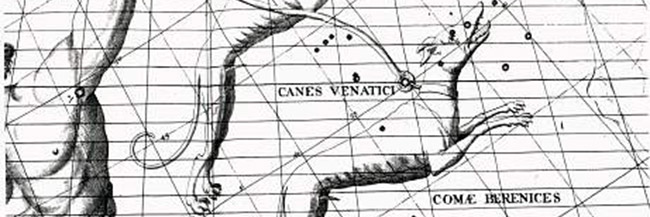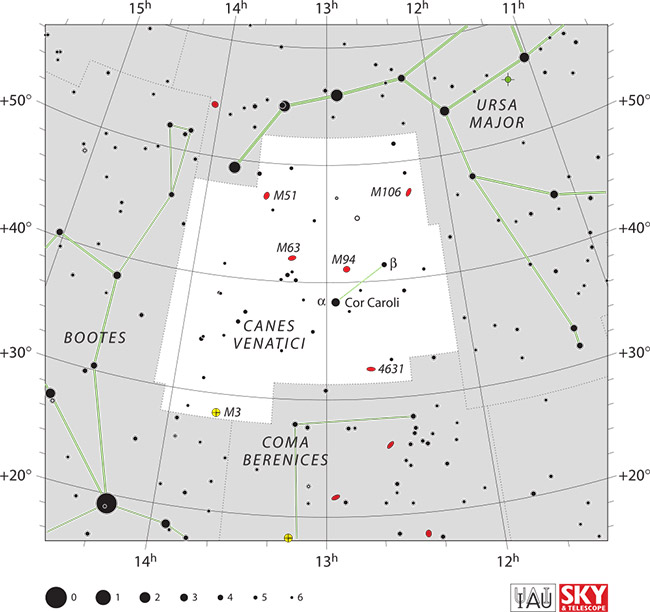Canes Venatici – Constellation Facts
 John Flamsteed, Public domain, via Wikimedia Commons
John Flamsteed, Public domain, via Wikimedia Commons
Canes Venatici is derived from the Latin language and means “hunting dogs,” representing the hunting dogs of the herdsman in the Bootes constellation. It can be found in the third quadrant of the Northern hemisphere and is located specifically between latitudes of +90° and -40°. This constellation is also home to the famous Cor Caroli and La Superba stars.
Constellation Characteristics
The relatively simple shape of Canes Venatici is the 38th largest constellation in the night sky, occupying 465 square degrees. Canes Venatici is also neighbors with Boötes, Coma Berenices and Ursa Major. In addition, this constellation has five stars, five Messiers and other deep space objects.

IAU and Sky & Telescope magazine (Roger Sinnott & Rick Fienberg), CC BY 3.0, via Wikimedia Commons
By IAU and Sky & Telescope magazine (Roger Sinnott & Rick Fienberg) CC BY 3.0, via Wikimedia CommonsPlanetary Systems
Canes Venatici has fourteen deep sky objects. Read on to discover some fascinating facts about the more notable of these celestial wonders.
- Messier 3 (NGC 5272): marked as one of the brightest and largest, this globular cluster contains an estimated 500,000 stars.
- Whirlpool Galaxy ~ Messier 51 (NGC 5194): this grand design spiral galaxy is one of the best known in the night sky. It is located an estimated 31 million light-years from the Milky Way and is actually connect by a tidal bridge to a dwarf galaxy also in this Messier (NGC 5195 (Messier 51b)). This pair of wonders can even be seen with binoculars.
- Sunflower Galaxy ~ Messier 63 (NGC 5055): considered a spiral galaxy, M63 is the second brightest member of this group. It is also located about 37 million light-years from Earth.
- Messier 94 (NGC 4736): located approximately 16 million light-years away, this spiral galaxy is notable for its two ring structures; inner ring is considered a ‘starburst ring’ and the outer ring has a complex structure of spiral arms.
- Messier 106 (NGC 4258): this spiral galaxy emits x-rays and part of it is suspected to be falling (at its core) into a supermassive black hole.
- Whale Galaxy (NGC 4631, Caldwell 32, Arp 281, PGC 42637): the shape of this galaxy gets its name from its whale-like appearance. It has an intense star formation and is located about 30 million light-years from Earth.
- NGC 5033: situated very close to NGC 5005, this spiral galaxy has a bright nucleus, is slightly inclined and also has a faint disk. Its Seyfert nucleus is believed to contain a supermassive black hole.
- NGC 5005 (Caldwell 29): in “partnership” with NGC 5033, this inclined spiral galaxy can be seen with even small telescopes.
- Hockey Stick Galaxies ~ NGC 4656 & NGC 4657 (Crowbar Galaxy, UGC 7907, PGC 42863): these galaxies are interacting and are located approximately 25 million light-years from here.
Main Stars
The constellation Canes Venatici contains five main stars that makes up its shape. Let’s explore them further.
- Cor Caroli (Alpha Canum Venaticorum) shines the brightest in the Cancer constellation (which will be discussed later in detail).
- Chara (Beta Canum Venaticorum) is the second brightest star in Canes Venatici. It is located about 24.7 light-years away and is classified as a G-type main sequence dwarf. Its name means “joy” in Greek and symbolizes the Southern dog.
- La Superba (Gamma Canum Venaticorum) is well known for being one of the most red stars in the night sky. This semi-regular variable star is losing its mass at a high rate and will soon form into a nebula then become a white dwarf.
- AM Canum Venaticorum is catalogued as a cataclysmic variable star; binary stars composed of a white dwarf and a mass-transferring secondary star.
- RS Canum Venaticorum is a class of variable stars that is made up of mostly close-set binary stars with variations in brightness.

John Flamsteed, Public domain, via Wikimedia Commons
Canes Venatici, two hunting dogs held on a leash by Boötes, seen in the Atlas Coelestis of John Flamsteed (1729)Most Shining Star
Out of all the stars that make up the Canes Venatici constellation, none shine brighter than Cor Caroli. Its name means “Charles’ Heart,” named in honor of Charles I (the King executed after the British Civil War). This binary star is composed of a brighter component that is laden in europium, mercury and silicon. The lesser component is a F-type main sequence star. Cor Caroli is located about 110 light-years away.
Mythology & History
The history of Canes Venatici can be traced back to the Middle Ages where there was a mistake in its translated name. In this time period, the constellation was symbolized as the two dogs the herdsman (Bootes) held on a leash and in his other hand he held a club. Some of the stars did belong in the herdsman’s club; however, when Ptolemy’s Almagest was translated into Latin the word for dogs (kilab) was mistaken for the word meaning” the spearhead with hooks” (al-`aşā dhāt al-kullāb). In the 17th century, the dog’s were defined in the night sky by Hevelius. He named the Northern dog Asterion, which in Greek means “little star” and the Southern one was called Chara for “joy.”
Canes Venatici is a fascinating constellation, so the next time you are gazing into the night sky, be sure to search out this intriguing figuration of stars.
